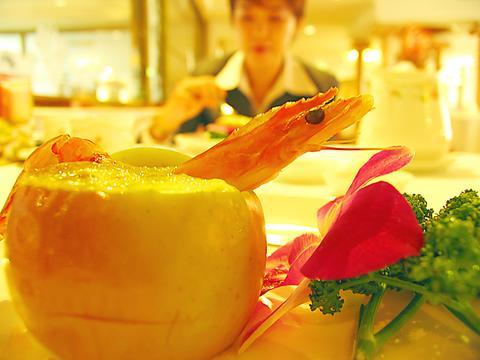For a fruity meal fit for a king take a ride up Linsen North Road to the Gloria Prince Hotel and enjoy a combination of sweet pulps, savory meats and fish -- including some rare and unusual items even the most experienced gourmand may not have tried before.
Once you are seated in the elegantly appointed dining room, with its gilded furniture and brightly polished chandeliers, settle down for what could be a two-hour plus gastronomic experience.

PHOTO: JULES QUARTLY, TAIPEI TIMES
There are nine items on the Fruit Set Menu, which was devised by head chef Peter Wu in June and has been continued because of its popularity. The winner of two consecutive cordon bleu contests in Taiwan, Wu hails from Hong Kong and specializes in Cantonese cooking, which he has internationalized for the local and high-end traveler set he services.
The only man to have been the head chef for two presidents on overseas trips (Lee Teng-hui (
The set menu begins with fiery dragon fruit canapes and ends with a mango ice crush. In between the highlights were some highly inventive dishes, only one of which did not succeed, in this reviewer's opinion. That was the seafood and apple with mayonnaise sauce, which looked good enough, but was slightly sickly with the combination of sweet apple and overbearingly rich mayo.
The rest was an adventure for the taste buds that was rewarded by some original and flavorsome combinations. The pumpkin with egg and fried shark's fin was a revelation. The scooped-out half-pumpkin, steamed and filled with lightly fried eggs and bean sprouts, set off the delicately prepared shark's fin. Usually, I find the taste of shark's fin unremarkable, but on this occasion it was a treat. The sharks used are farmed, apparently, so conservationists need not be upset. The dish came with one of the most delicious clear broths I have ever tried. Made from ham, chicken, pork ribs, pumpkin, dried scallops and spices (the chef refuses to disclose), it is boiled, reduced and strained for days to form a golden nectar that is strong, yet refined in taste.
Braised beef and mango went together surprisingly well, the scallop dishes were superb and the deep fried banana fruit rolls were impeccable.
However, the most remarkable dish, fittingly enough, came last. Hasma sweet soup in papaya sounds bland enough, but the reproductive glands of the snow frog, dried, rehydrated and double-boiled with rock sugar, is a unique culinary invention that was previously only eaten by emperors. The hermaphrodite snow frog's sperm and ova form a glutinous and opaque dessert after cooking. It sounds weird and feels like tapioca in the mouth, but with a slightly salty after taste. Yes, indeed, a funny experience.

On April 26, The Lancet published a letter from two doctors at Taichung-based China Medical University Hospital (CMUH) warning that “Taiwan’s Health Care System is on the Brink of Collapse.” The authors said that “Years of policy inaction and mismanagement of resources have led to the National Health Insurance system operating under unsustainable conditions.” The pushback was immediate. Errors in the paper were quickly identified and publicized, to discredit the authors (the hospital apologized). CNA reported that CMUH said the letter described Taiwan in 2021 as having 62 nurses per 10,000 people, when the correct number was 78 nurses per 10,000

As we live longer, our risk of cognitive impairment is increasing. How can we delay the onset of symptoms? Do we have to give up every indulgence or can small changes make a difference? We asked neurologists for tips on how to keep our brains healthy for life. TAKE CARE OF YOUR HEALTH “All of the sensible things that apply to bodily health apply to brain health,” says Suzanne O’Sullivan, a consultant in neurology at the National Hospital for Neurology and Neurosurgery in London, and the author of The Age of Diagnosis. “When you’re 20, you can get away with absolute

May 5 to May 11 What started out as friction between Taiwanese students at Taichung First High School and a Japanese head cook escalated dramatically over the first two weeks of May 1927. It began on April 30 when the cook’s wife knew that lotus starch used in that night’s dinner had rat feces in it, but failed to inform staff until the meal was already prepared. The students believed that her silence was intentional, and filed a complaint. The school’s Japanese administrators sided with the cook’s family, dismissing the students as troublemakers and clamping down on their freedoms — with

As Donald Trump’s executive order in March led to the shuttering of Voice of America (VOA) — the global broadcaster whose roots date back to the fight against Nazi propaganda — he quickly attracted support from figures not used to aligning themselves with any US administration. Trump had ordered the US Agency for Global Media, the federal agency that funds VOA and other groups promoting independent journalism overseas, to be “eliminated to the maximum extent consistent with applicable law.” The decision suddenly halted programming in 49 languages to more than 425 million people. In Moscow, Margarita Simonyan, the hardline editor-in-chief of the